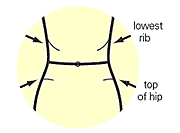There are 2 ways to find out if you're a healthy weight:
1. waistline measurement
2. body mass index (BMI).
A waistline measurement is a better indication of fat distribution. BMI doesn't provide an accurate measure of fat versus muscle mass.
Waistline measurements
 Our research shows that a waistline of more than 94cm for men and 80cm for women increases the risk for some types of cancer, while a waistline of more than 102cm for men and 88cm for women greatly increases your risk.
Our research shows that a waistline of more than 94cm for men and 80cm for women increases the risk for some types of cancer, while a waistline of more than 102cm for men and 88cm for women greatly increases your risk.
Many people measure their waist incorrectly (in the wrong spot), or rely on their belt or trouser size, which is often inaccurate. For an accurate waist measurement make sure you:
- measure directly over your skin or no more than one item of light clothing
- take the measurement after breathing out normally
- have the tape measure fitting snug, but not compressing the skin
- measure at the halfway point between your lowest rib and the top of your hipbone. This will be roughly in-line with your belly button.
Body Mass Index
To calculate body mass index (BMI), divide weight (in kilograms) by height (in metres squared).
Example: Bob is 1.74 m tall and weighs 82 kg. To calculate his BMI:
82 ÷ 1.74 ÷ 1.74 = 27kg/m2
(weight ÷ height ÷ height = BMI)
The desirable range is from 18.5 to 25kg/m2. The following applies to adults:
- A BMI less than 18.5 kg/m2 means you're underweight.
- A BMI more than 25 kg/m2 means you're overweight.
- A BMI more than 30 kg/m2 means you're obese.
The average BMI for Australian women is 26kg/m2 and for men 27kg/m2, which means the average Australian is overweight.
Use the LiveLighter BMI calculator